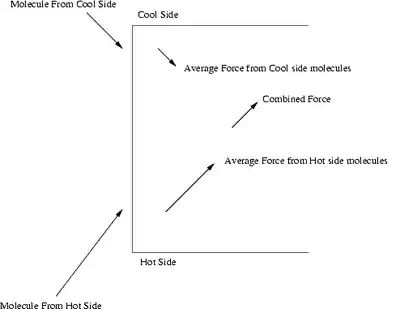Thermal transpiration
Thermal transpiration (or thermal diffusion) refers to the thermal force on a gas due to a temperature difference. Thermal transpiration causes a flow of gas in the absence of any pressure difference, and is able to maintain a certain pressure difference called thermomolecular pressure difference in a steady state. The effect is strongest when the mean free path of the gas molecules is comparable to the dimensions of the gas container.

Diagram showing pressure difference induced by a temperature difference.
Thermal transpiration appears as an important correction in the readings of vapor pressure thermometers,[1][2] and the effect is historically famous as being an explanation for the rotation of the Crookes radiometer.[3][4]
See also
- Knudsen pump — a gas pump with no moving parts which functions via thermal transpiration.
- Thermophoresis (Soret effect) — diffusion of colloidal particles in a liquid, induced by a temperature gradient.
References
- Watkins, R. A. (1967). "Thermomolecular Pressure Difference Measurements for Precision Helium−3 and Helium−4 Vapor-Pressure Thermometry". The Journal of Chemical Physics. 46 (3): 1007. Bibcode:1967JChPh..46.1007W. doi:10.1063/1.1840762.
- Pobell, F. (2007). Matter and Methods at Low Temperatures (3rd ed.). Springer. ISBN 978-3-540-46356-6.
- "On certain dimensional properties of matter in the gaseous state" Osborne Reynolds, Royal Society Phil. Trans., Part 2, (1879)
- "On stresses in rarefied gases arising from inequalities of temperature" James Clerk Maxwell, Royal Society Phil. Trans. (1879)
This article is issued from Wikipedia. The text is licensed under Creative Commons - Attribution - Sharealike. Additional terms may apply for the media files.